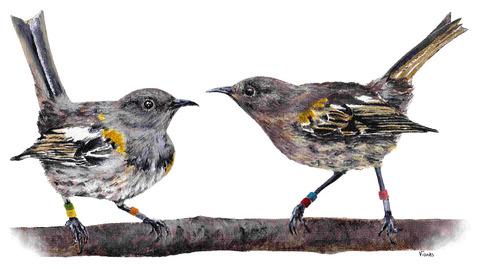当前位置:
X-MOL 学术
›
Anim. Conserv.
›
论文详情
Our official English website, www.x-mol.net, welcomes your feedback! (Note: you will need to create a separate account there.)
Changes in social groups across reintroductions and effects on post‐release survival
Animal Conservation ( IF 3.4 ) Pub Date : 2019-12-11 , DOI: 10.1111/acv.12557 V. R. Franks 1, 2 , C. E. Andrews 1, 2 , J. G. Ewen 2 , M. McCready 3, 4 , K. A. Parker 5 , R. Thorogood 1, 6, 7
Animal Conservation ( IF 3.4 ) Pub Date : 2019-12-11 , DOI: 10.1111/acv.12557 V. R. Franks 1, 2 , C. E. Andrews 1, 2 , J. G. Ewen 2 , M. McCready 3, 4 , K. A. Parker 5 , R. Thorogood 1, 6, 7
Affiliation

|
Reintroductions, essential to many conservation programmes, disrupt both abiotic and social environments. Despite growing recognition that social connections in animals might alter survival (e.g. social transmission of foraging skills, or transmission of disease), there has thus far been little focus on the consequences of social disruption during reintroductions. Here we investigate if moving familiar social groups may help a threatened species to adjust to its new environment and increase post‐release survival. For a reintroduction of 40 juvenile hihi Notiomystis cincta (a threatened New Zealand passerine), we observed social groups before and after translocation to a new site and used social network analysis to study three levels of social change: overall group structure, network associations and individual sociality. We also tested alternate translocation strategies where birds were kept temporarily in aviaries in either a familiar group, or where their prior association was mixed. Although social structure remained similar among juveniles that remained at the source site, we detected significant changes in translocated birds at both the group‐ and individual‐ level post‐release. However, our holding treatments did not affect these social bonds so we remain unable to maintain or manipulate social groups during translocation. Crucially, there was a small tendency for translocated juveniles that gained more associates during re‐assortment of social groups to be more likely to survive their first year post‐release. We suggest that prior sociality may not be important during translocations, but rather individuals that are most able to adapt and form associations at a new site are most likely to be the surviving founders of reintroduced populations.
中文翻译:

重新引入社会群体的变化及其对释放后生存的影响
对许多保护计划必不可少的重新引入,会破坏非生物和社会环境。尽管人们日益认识到动物中的社交关系可能会改变生存方式(例如,觅食技能的社交传播或疾病的传播),但迄今为止,很少有人关注再引入过程中社交破坏的后果。在这里,我们调查了熟悉的社会群体的移动是否可以帮助受威胁物种适应其新环境并提高释放后的生存率。为重新引入40只hihi Notiomystis cincta(濒临灭绝的新西兰雀形目),我们在迁移到新站点之前和之后观察了社会群体,并使用社交网络分析研究了三个社会变化级别:整体群体结构,网络协会和个人社交。我们还测试了其他易位策略,即将鸟类暂时关在熟悉的组中的鸟舍中,或者将先前的亲戚混在一起。尽管留在源头的幼鸟的社会结构仍然相似,但我们在团体和个人一级的释放后都发现了易位鸟类的显着变化。但是,我们的持股待遇并未影响这些社会纽带,因此我们在迁移期间仍然无法维持或操纵社会群体。至关重要的是 在社会群体重新分配期间,易位的青少年有一个较小的趋势,该群体获得了更多的同伴,从而更有可能在释放后的第一年生存。我们建议,在迁移过程中,事先的社交活动可能并不重要,但最有能力在新地点适应并形成关联的个体最有可能是重新引入的种群的幸存创始人。
更新日期:2019-12-11
中文翻译:

重新引入社会群体的变化及其对释放后生存的影响
对许多保护计划必不可少的重新引入,会破坏非生物和社会环境。尽管人们日益认识到动物中的社交关系可能会改变生存方式(例如,觅食技能的社交传播或疾病的传播),但迄今为止,很少有人关注再引入过程中社交破坏的后果。在这里,我们调查了熟悉的社会群体的移动是否可以帮助受威胁物种适应其新环境并提高释放后的生存率。为重新引入40只hihi Notiomystis cincta(濒临灭绝的新西兰雀形目),我们在迁移到新站点之前和之后观察了社会群体,并使用社交网络分析研究了三个社会变化级别:整体群体结构,网络协会和个人社交。我们还测试了其他易位策略,即将鸟类暂时关在熟悉的组中的鸟舍中,或者将先前的亲戚混在一起。尽管留在源头的幼鸟的社会结构仍然相似,但我们在团体和个人一级的释放后都发现了易位鸟类的显着变化。但是,我们的持股待遇并未影响这些社会纽带,因此我们在迁移期间仍然无法维持或操纵社会群体。至关重要的是 在社会群体重新分配期间,易位的青少年有一个较小的趋势,该群体获得了更多的同伴,从而更有可能在释放后的第一年生存。我们建议,在迁移过程中,事先的社交活动可能并不重要,但最有能力在新地点适应并形成关联的个体最有可能是重新引入的种群的幸存创始人。


























 京公网安备 11010802027423号
京公网安备 11010802027423号